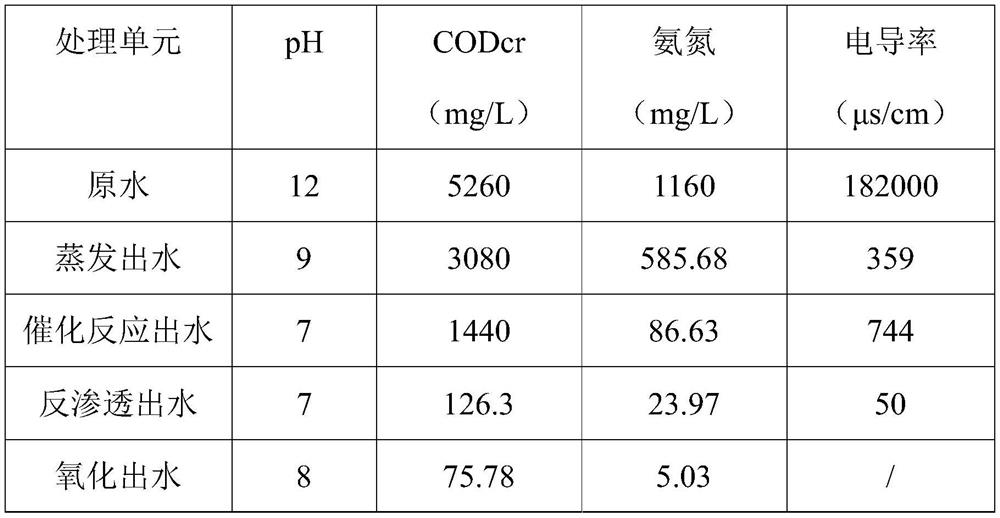Treatment process for hydrazine hydrate wastewater
A technology for wastewater treatment and hydrazine hydrate, which is applied in water/sewage treatment, degassed water/sewage treatment, oxidized water/sewage treatment, etc. The problem of large amount of addition, to achieve the effect of simplifying the process, reducing the concentration of pollution, and long service life
- Summary
- Abstract
- Description
- Claims
- Application Information
AI Technical Summary
Problems solved by technology
Method used
Image
Examples
Embodiment 1
[0038] Step 1: collecting hydrazine hydrate wastewater;
[0039] Step 2: send the collected raw water of hydrazine hydrate wastewater into the evaporation system for evaporation, and collect the evaporation condensate; the salt evaporates and crystallizes, and is packaged and recovered after centrifugation;
[0040] Step 3: discharge the condensate produced by evaporation into the catalytic reaction tank, add copper sulfate and aerate, the concentration of copper sulfate in the catalytic reaction tank is controlled at 0.4mmol / L, the pH is controlled between 6 and 9, and the residence time of wastewater is 40h;
[0041] Step 4: The effluent from the catalytic reaction tank passes through the multi-media filter, ultrafiltration system, and reverse osmosis system in sequence. The flow rate of the multi-media filter is 10m / h. The reverse osmosis system is arranged in two stages. The ratio is 2:1, the concentrated water in the first stage returns to the front of the high-pressure p...
Embodiment 2
[0048] The hydrazine hydrate wastewater treatment process provided by the present embodiment is basically the same as in Example 1, the difference is that:
[0049]1. The raw water in this embodiment is the condensate after MVR evaporation;
[0050] 2. In this example, the wastewater produced by reverse osmosis has reached the first-class standard, and there is no need to add an oxidant to oxidize;
[0051] Specific steps are as follows:
[0052] Step 1: The raw water is discharged into the catalytic reaction tank, copper sulfate is added and aerated, the concentration of copper sulfate in the catalytic reaction tank is controlled at 0.2mmol / L, the pH is controlled between 6 and 9, and the wastewater residence time is 24h;
[0053] Step 2: The effluent from the catalytic reaction tank passes through the multi-media filter, ultrafiltration system, and reverse osmosis system in sequence. The flow rate of the multi-media filter is 10m / h. The reverse osmosis system is arranged in...
Embodiment 2
[0055] Embodiment 2 The effluent water quality of each main treatment unit is as follows:
[0056]
[0057] Comparing Example 1 and Example 2, it can be seen that when the CODcr and ammonia nitrogen indicators of the raw water are respectively 2400mg / L and 2300mg / L, the reverse osmosis effluent can reach the first-class standard. The CODcr and ammonia nitrogen indicators of the catalyzed reaction effluent in Examples 1 and 2 are significantly lower than those of the evaporated effluent, indicating that the copper salt has a good catalytic effect on the pollutants in the hydrazine hydrate wastewater.
PUM
| Property | Measurement | Unit |
|---|---|---|
| pore size | aaaaa | aaaaa |
| thickness | aaaaa | aaaaa |
Abstract
Description
Claims
Application Information
 Login to View More
Login to View More - R&D
- Intellectual Property
- Life Sciences
- Materials
- Tech Scout
- Unparalleled Data Quality
- Higher Quality Content
- 60% Fewer Hallucinations
Browse by: Latest US Patents, China's latest patents, Technical Efficacy Thesaurus, Application Domain, Technology Topic, Popular Technical Reports.
© 2025 PatSnap. All rights reserved.Legal|Privacy policy|Modern Slavery Act Transparency Statement|Sitemap|About US| Contact US: help@patsnap.com



